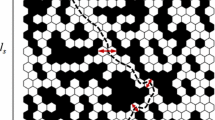Abstract
In this theoretical study, characteristic or effective permeabilities (referred to as ‘apparent permeability’) of a radial/parallel flow system in a heterogeneous medium are calculated by the Monte Carlo method and the finite element method. The permeability distribution in the radial and parallel flow systems are not the same, as going from Cartesian to cylindrical coordinates changes the probability measure. The Bernoulli trials, the normal distribution or the log-normal distribution, is assumed to be the probability density function of permeability. The results are summarized as follows: (1) when the skewness of the distribution function is equal to zero or nearly equal to zero (that is, when the permeability distribution is regarded to be symmetric), the apparent permeability depends on the standard deviation, but not on the kind of distribution function, (2) when the skewness is not equal to zero, the apparent permeability depends not only on the standard deviation, but also on the skewness, (3) the above facts appeared in the radial and the parallel flow systems.
Similar content being viewed by others
Abbreviations
- K :
-
dimensionless permeability,K=k/k A
- K ap :
-
dimensionless apparent permeability,K ap=k ap/k A
- ¯K ap :
-
average value of apparent permeabilities calculated by the Monte Carlo method (defined by Equation (18))
- k :
-
permeability [m2]
- m :
-
sub-section number inz-direction
- N :
-
frequency in the Bernoulli trial
- n :
-
sub-section number inx-direction
- n r :
-
sub-section number inr-direction
- n t :
-
trial number of computation of apparent permeability
- n θ :
-
sub-section number inθ-direction
- P :
-
dimensionless pressure,P=(p−p out )/(P in−p out)
- p :
-
pressure [Pa]
- Q :
-
volume flow rate per unit length [m2/s]
- q :
-
flow flux [m/s]
- R :
-
dimensionless variable inr-direction,R=r/r in
- r, θ :
-
directions in the cylindrical coordinate system
- S k :
-
skewness (defined in Equation (19))
- x, z :
-
directions in the rectangular coordinate system
- X 1 :
-
dimensionless medium length ofx-direction,X 1=x 1/x *
- x * :
-
characteristic length
- Z 1 :
-
dimensionless medium length ofz-direction,Z 1=z 1/x *
- Μ :
-
arithmetic mean of ln(K) in the log-normal distribution
- Μ f :
-
viscosity of fluid [Pa s]
- Μ 3 :
-
central moment of third-order
- σ :
-
standard deviation
- σ * :
-
standard deviation of ln(K) in the log-normal distribution
- A:
-
arithmetic
- ap:
-
apparent
- in:
-
inlet
- L:
-
larger value in the Bernoulli trials
- out:
-
outlet
- S:
-
smaller value in the Bernoulli trials
References
Ababou, R., Mclaughlin, D., Gelhar, L. W., and Tompson, A. F. B., 1989, Numerical simulation of three-dimensional saturated flow in randomly heterogeneous porous media,Transport in Porous Media 4, 549–565.
Dagan, G., 1982, Stochastic modeling of groundwater flow by unconditional and conditional probabilities, 1. Conditional simulation and the direct problem,Water Resour. Res. 18, 813–833.
Desbarats, A. J., 1987, Numerical estimation of effective permeability in sand-shale formations,Water Resour. Res. 23, 273–286.
El-Kadi, A. I. and Brutsaert, W., 1985, Applicability of effective parameters for unsteady flow in nonuniform aquifers,Water Resour. Res. 21, 183–198.
Gutjahr, A. L., Gelhar, L. W., Bakr, A. A., and MacMillan, J. R., 1978, Stochastic analysis of spatial variability in subsurface flows, 2. Evaluation and application,Water Resour. Res. 14, 953–959.
Gomez-Hernandez, J. J. and Gorelick, S. M., 1989, Effective ground-water model parameter: Influence of spatial variability of hydraulic conductivity, leakance, and recharge,Water Resour. Res. 25, 405–419.
King, P. R., 1989, The use of renormalization for calculating effective permeability,Transport in Porous Media 4, 37–58.
Matheron, G., 1967, Composition des perméabilités en milieu poreux hétérogène: méthode de Schwydler et règles de pondération,Rev. Inst. Fr. Pet. 22, 443–466.
Matheron, G., 1967,Eléments pour une théorie des milieux poreux, Masson, Paris.
Moreno, L., Tsang, Y. W., Tsang, C. F., Hale, F. V., and Neretnieks, I., 1988, Flow and tracer transport in a single fracture: A stochastic model and its relation to some field observations,Water Resour. Res. 24, 2033–2048.
Moreno, L., Tsang, C. F., Tsang, Y., and Neretnieks, I., 1990, Some anomalous fractures of flow and solute transport arising from fracture aperture variability,Water Resour. Res. 26, 2377–2391.
Warren, J. E. and Price, H. S., 1961, Flow in heterogeneous porous media,SPEJ 1, 153–169.
Author information
Authors and Affiliations
Rights and permissions
About this article
Cite this article
Niibori, Y., Chida, T. The use of standard deviation and skewness for estimating apparent permeability in a two-dimensional, heterogeneous medium. Transp Porous Med 15, 1–14 (1994). https://doi.org/10.1007/BF01046155
Received:
Revised:
Issue Date:
DOI: https://doi.org/10.1007/BF01046155




